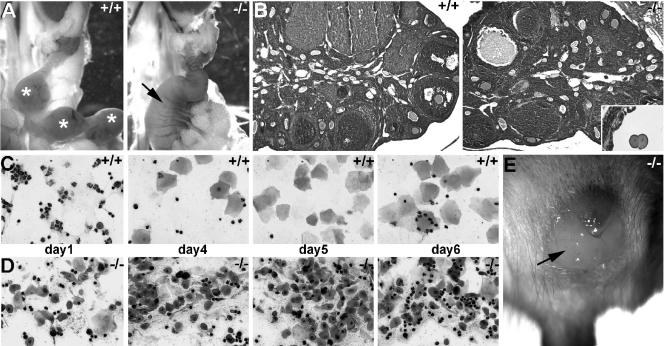FIG. 6.
Comparison of wild-type and perilacZ null female reproductive capabilities. (A) The genital tracts of 10-week-old female +/+ and −/− mice that had been plugged by fertile +/+ males. Note that the wild-type uterus has several individual E6.5 decidual swellings (indicated by *), while the null uteruses had undergone a proliferative response and are uniformly enlarged and highly vascularized (arrow). However, histological analysis revealed that only the wild-type uterus had implanted E6.5 embryos present. (B) Ovaries of 8 week-old +/− and −/− females were histologically similar (relative numbers of primordial, primary, and antral follicles as well as of corpora lutea were similar), although the null ovaries were proportionally smaller. Sectioning of the null oviducts revealed that two-cell null embryos were present (inset in B). (C and D) Vaginal smear samples taken during littermate estrous cycles revealed that while the wild-type mice had normal cycles, the nulls failed to cycle. (C) The wild-type mice had the normal 2- to 3-day diestrus (evidenced by presence of leukocytes almost exclusively) followed by rapid preestrus (equal numbers of leukocytes and nucleated epithelial cells), estrus (large transparent squamous epithelial cells), and postestrus (equal numbers of leukocytes and transparent squamous folded epithelial cells). (D) However, the null smear samples failed to reveal any recognizable phases of the menstrual cycle and appear to reflect a continuous postestrus/shedding stage. (E) Null vaginal copulation plugs abnormally persisted for up to 3 days (arrow), while wild-type plugs usually fell out within 12 h (n = 16 mice).

